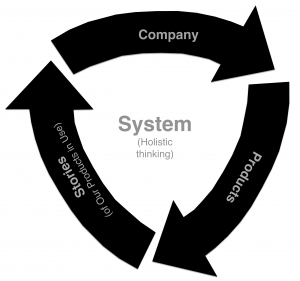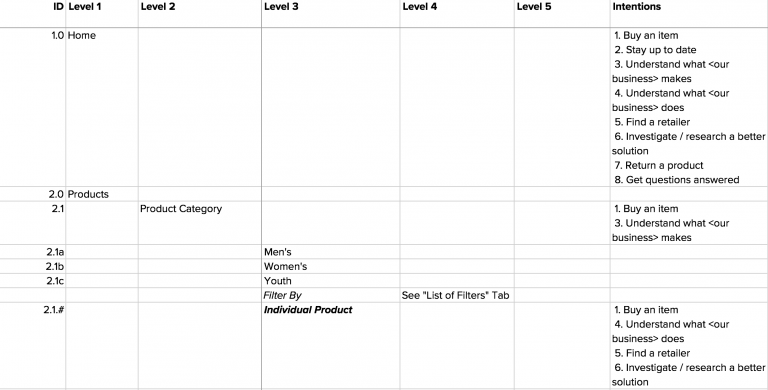Our journey through understanding designing for customer intentions, defining said intentions, and communicating unique business values has hopefully been informative. However, despite whatever knowledge you may have gleaned I’m sure one question still remains:
Once you have customer intentions defined, how do you put those intentions to use?
There are a myriad of ways one could and should use intentions when designing their website. In what follows I’ll share a few of the ways we apply intentions in our work. I do so simply for inspiration’s sake, as I encourage you to use intentions however and wherever you can. After-all, you’re in business to make your customers lives better. One surefire way to do so is to ease their path to success by designing a website that’s aimed at helping them satisfy their intentions.
More on that another time. For now, let’s talk answers.
For these answers let’s bring back the example Customer Intentions list defined earlier in the series:
When a customer goes to the website they intend to…
- Buy an item
- Stay up to date
- Understand what (our business) makes
- Understand what (our business) does
- Find a retailer
- Investigate / research a better solution
- Return a product
- Get questions answered
Allow me to walk you through some example exercises and outputs we’d create using this list. I’ll start with the most abstract/strategic exercises, then work down to the concrete/detailed.
1. Concept Modeling
One of the exercises we do at the start of any website project is to create a concept model. We use this model to define the overall groups of information which need to exist on the site to communicate the unique business value while satisfying customer intentions. Here is a concept model based off our list:

If you compare the list to the model you can see where intentions overlap with groups of website information. I’ve mapped this out below:
When a customer goes to the website they intend to…
- Buy an item – Products
- Stay up to date – Company
- Understand what (our business) makes – Products, System
- Understand what (our business) does – Company, System
- Find a retailer – Company
- Investigate / research a better solution – Stories, Products, System
- Return a product – Company, Products
- Get questions answered – Company
In this example, we know when coming to the site one intention the customer has is to understand what the company makes. Using intentions here means we ensure our concept model includes one to many groups (i.e. “Products”) that will contain the information necessary (i.e. a list of products) to satisfy this intention. The important point here is to be sure each intention can be mapped to a group, and all the groups map to at least one intention.
2. Content Modeling and Mapping
Another way we use intentions is when we define the details of the concept model groups. These details include the pages and content/features that will need to exist on the site. There are many detailed steps we take during this time, and below are just a few examples which show intentions usage:

To get to the above content map we’ve asked ourselves questions such as “If a customer intends to ‘understand what the business does and what it makes’, what type of information or features do we need to have in our groups to meet these intentions?”. The answers become a long list of content and/or features. We take this list and organize into pages to create the content map.
At the same time, we organize our long list of features and content into a content architecture spreadsheet. Example:

We map each page (Levels 1, 2, and 3) directly to one / many customer intentions ensuring all website content and features related to at least one intention and vice versa.
Full Disclosure: Be sure to brace yourself during this exercise as for most teams it is the moment of truth.
During this time each page of the site and each feature or piece of content that exists on a page needs tie back to satisfying one to many customer intentions. If an intention isn’t represented in a page, in the content, or in the feature list we know something needs to be added. Easy enough.
Here’s where it gets difficult. If a page, piece of content, or feature exists without a matching intention it probably isn’t needed and should be discarded. This is usually very hard for business to accept. Yet, this is the most critical piece in creating a site geared towards meeting intentions. Miss this and your business is back to throwing too much information at your customers which means your site and your unique business value re-enter the realm of confusion. This is the exact situation designing for intentions is meant to avoid.
I encourage you to stay strong and have faith in your business value and your customers’ intentions. They won’t fail you.
3. User Flows
A third way we bake intentions in is when modeling how the customer could move through the site to satisfy an intention.

Understanding that customers are humans who don’t move linearly through sites, we’ve been inspired to update our model. This model aims to capture the many dimensions of navigating a website. The center hexagon represents the page a user is currently viewing. Surrounding that spoke are the potential pages the user can click to based off of the content or features are available. We model out as much as needed to visualize and validate users can indeed satisfy their intentions using the pages and content we’ve defined.
4. Interaction and Interface Design
With this foundation we move forward into interaction and interface design. For us this means looking at our content map to see which pages needed to be created, looking at our content architecture to figure out what goes on each page, looking at our user flows to understand the interplay between pages, and then constructing an interaction model which serves as the template for our interface design.
We’ll then use the customer intentions list to fact check the resulting outputs. This ensures the design and development deliverables line up with the strategy we’ve defined.
5. Content
Lastly, we’re sure to keep intentions in mind when reviewing the content of the site. This means we work to check that the messaging, tone, and voice all communicate what the customer need in order to understand the unique business value, formulate their intentions, and use the website to satisfy those intentions.
In Conclusion
By now you’ve gotten a few ideas of how you can utilize the customer intentions you’ve defined to help your customers more easily meet their goals. As we’ve said time and again, working through this practice is key to increasing customer loyalty and your business’s bottom line.
Something we haven’t yet discussed is how designing for customer intentions is also key to aligning your site with how the web has shifted, and will continue to shift, the ways we humans take in information.
More on this point in our discussions to come.